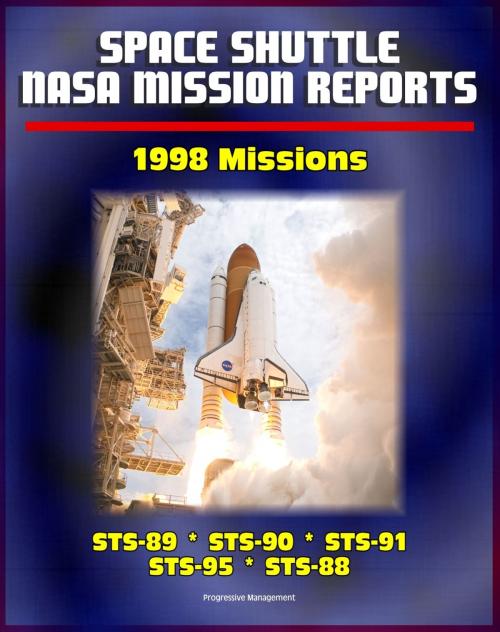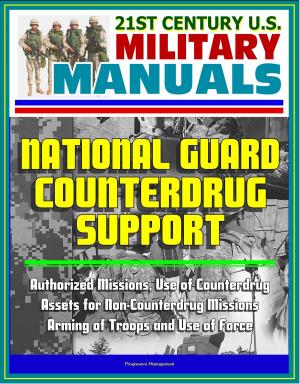Space Shuttle NASA Mission Reports: 1998 Missions, STS-89, STS-90, STS-91, STS-95, STS-88
Nonfiction, Science & Nature, Science, Physics, Astrophysics & Space Science, Other Sciences, History| Author: | Progressive Management | ISBN: | 9781465840448 |
| Publisher: | Progressive Management | Publication: | January 17, 2012 |
| Imprint: | Smashwords Edition | Language: | English |
| Author: | Progressive Management |
| ISBN: | 9781465840448 |
| Publisher: | Progressive Management |
| Publication: | January 17, 2012 |
| Imprint: | Smashwords Edition |
| Language: | English |
These official final program mission reports issued by the NASA Johnson Space Center cover missions in 1998: STS-89, STS-90, STS-91, STS-95, and STS-88. In these thorough reports, with information and specifics not available on NASA website mission descriptions, each orbiter system is reviewed in detail along with technical information on performance and anomalies.
STS-89: The primary objectives of the STS-89 flight were to rendezvous and dock with the Mir Space Station, and perform the exchange of a Mir astronaut. A double Spacehab module and the crew compartment carried science experiments and hardware, Risk Mitigation Experiments (RMEs), Russian Logistics, Astroculture (AST), two Mechanics of Granular Materials (MGM), Cosmic Radiation Effects and Activation Monitor (CREAM), and Space Acceleration Measurement system (SAMS) in support of the Phase 1 Program requirements.
STS-90: The primary objective of the STS-90 flight was to successfully perform the planned operations of the Neurolab. The secondary objectives of this flight were to perform the requirements of Shuttle Vibration Forces (SVF), Bioreactor Demonstration System-04 (BDS-04), and three Get-Away Specials (GAS).
STS-91: The primary objectives of the STS-91 flight were to rendezvous and dock with the Mir Space Station, and return the NASA 7 Mir Astronaut. A single Spacehab module was to carry Russian Logistics, science experiments and Risk Mitigation Experiments (RMEs).
STS-95: The primary objectives of the STS-95 flight were to perform operations of Research Payloads in a single Spacehab module, the Hubble Orbital Systems Test (HOST) Platform, International Extreme Ultraviolet Hitchhiker (IEH-03), SPARTAN 201, Cryogenic Thermal Storage Unit (CRYOTSU), and two Get-Away Special (GAS) Carrier Payloads.
STS-88: The primary objectives of the STS-88 mission were to deliver and assemble the 2S Launch Package (LP) to the orbiting International Space Station (ISS) Stage 1. Prior to rendezvous, the Cargo Element (CE), which consisted of Node 1 with Pressurized Mating Adapter-1 (PMA-1) and PMA-2 pre-integrated on the Node 1 axial ports, was installed on the Orbiter Docking System (ODS) using the Shuttle Remote Manipulator System (SRMS). After final approach to Stage 1, the SRMS was used to capture Stage 1 and berth it to the PMA-1 Androgynous Peripheral Docking System (APDS).
These official final program mission reports issued by the NASA Johnson Space Center cover missions in 1998: STS-89, STS-90, STS-91, STS-95, and STS-88. In these thorough reports, with information and specifics not available on NASA website mission descriptions, each orbiter system is reviewed in detail along with technical information on performance and anomalies.
STS-89: The primary objectives of the STS-89 flight were to rendezvous and dock with the Mir Space Station, and perform the exchange of a Mir astronaut. A double Spacehab module and the crew compartment carried science experiments and hardware, Risk Mitigation Experiments (RMEs), Russian Logistics, Astroculture (AST), two Mechanics of Granular Materials (MGM), Cosmic Radiation Effects and Activation Monitor (CREAM), and Space Acceleration Measurement system (SAMS) in support of the Phase 1 Program requirements.
STS-90: The primary objective of the STS-90 flight was to successfully perform the planned operations of the Neurolab. The secondary objectives of this flight were to perform the requirements of Shuttle Vibration Forces (SVF), Bioreactor Demonstration System-04 (BDS-04), and three Get-Away Specials (GAS).
STS-91: The primary objectives of the STS-91 flight were to rendezvous and dock with the Mir Space Station, and return the NASA 7 Mir Astronaut. A single Spacehab module was to carry Russian Logistics, science experiments and Risk Mitigation Experiments (RMEs).
STS-95: The primary objectives of the STS-95 flight were to perform operations of Research Payloads in a single Spacehab module, the Hubble Orbital Systems Test (HOST) Platform, International Extreme Ultraviolet Hitchhiker (IEH-03), SPARTAN 201, Cryogenic Thermal Storage Unit (CRYOTSU), and two Get-Away Special (GAS) Carrier Payloads.
STS-88: The primary objectives of the STS-88 mission were to deliver and assemble the 2S Launch Package (LP) to the orbiting International Space Station (ISS) Stage 1. Prior to rendezvous, the Cargo Element (CE), which consisted of Node 1 with Pressurized Mating Adapter-1 (PMA-1) and PMA-2 pre-integrated on the Node 1 axial ports, was installed on the Orbiter Docking System (ODS) using the Shuttle Remote Manipulator System (SRMS). After final approach to Stage 1, the SRMS was used to capture Stage 1 and berth it to the PMA-1 Androgynous Peripheral Docking System (APDS).















